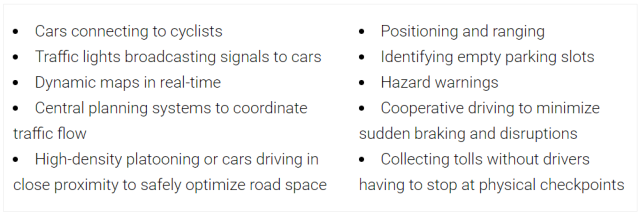5G and the future of cellular vehicle-to-everything (C-V2X) services
by Alepo Technologies Inc Digital enablement and revenue management softwareCellular Vehicle-to-Everything (C-V2X)
The automotive sector is on the brink of a digital revolution with the commencement of 5G, bringing new opportunities for cellular vehicle-to-everything (C-V2X) technology. Next-gen capabilities such as ultra-reliable low-latency communication (URLLC) and high bandwidth are set to transform connected cars and, ultimately, the way we travel.
Existing cellular technology addresses some V2X requirements, so what makes 5G so different? Combined with fast-developing AI and sensor technologies, 5G will enable completely autonomous vehicles. This means the possibility of eliminating or minimizing road accidents by enabling vehicles to share data in real-time and avoid accidents. In addition, 5G-powered self-driving cars will also vastly improve vehicular performance through energy optimization, ensure traffic efficiency, provide faster routes through accurate route mapping, enable safer roads by letting drivers “see” beyond their visual horizon, and much more. V2X will not only help vehicles communicate with each other and prevent accidents and hazards, but it will also help protect pedestrians with the PC5 interface integrated into their smartphones.
The result: significantly improved quality of life and tremendous monetary savings.
V2X capabilities and transmission modes
The connected cars of today have been evolving for years to become increasingly connected, intelligent, autonomous, and efficient. Apart from reducing latency and enhancing safety, cellular V2X also brings new capabilities to the table.
As a part of 3GPP release 14, V2X includes two transmission modes that collectively enable several use cases:
Direct C-V2X (Cellular V2X) – operates in its own 5.9 GHz spectrum that is independent of mobile networks. It includes the following use cases:
- Cars connecting to each other – Vehicle to Vehicle (V2V)
- Cars connecting to pedestrians – Vehicle to Pedestrians (V2P)
- Cars connecting to infrastructure like street signals – Vehicle to Infrastructure (V2I)
Vehicle to Network (V2N) – relies on traditional licensed mobile spectrum
In Release 16, too, direct C-V2X can operate without dependence on cellular networks. However, 5G connectivity helps build an ecosystem of highly reliable and accurate devices that enable autonomous vehicles. These include sensors, cameras, light detection devices, real-time car-to-car communications, and more. With 5G’s ability to support a large number of connected devices in a small geographical area, vehicles will be able to access more data about their surroundings.
C-V2X use cases enabled by 5G
The V2X ecosystem enables a broad range of services for connected car environments, and 5G takes accuracy to new heights. Some high-value use cases include:

Why it demands an edge core
Today, autonomous cars like Tesla and Zoox are highly advanced and require mission-critical low-latency. 5G URLLC enables them to fully meet their potential. The 5G edge core is essential in enabling mobile network operators to cater to 5G connected cars by helping keep latency low, maintaining safety even for vehicles driving at high speeds.
How does 5G core enable V2X?
An edge core with high transaction per second (TPS) is imperative for C-V2X. Alepo’s 5G Converged Core provides V2X support, including V2X subscriptions and policies, the capability to configure and maintain V2X subscription parameters, and more. It allows UEs to be authorized for V2X capability in both EPC and 5GC. UEs can be classified into two types – vehicle and pedestrian – each having its own QoS parameters.
Alepo’s Policy Control Function (PCF) will help configure policies for vehicle and pedestrian UEs. The operator can launch innovative V2X services by defining parameters such as RAT, transmission profile, communication mode, and signaling protection mode. Individual services can then be associated with a V2X policy, customizable for different geographical areas and radio parameters.
With Alepo’s Subscriber Data Management (SDM) agent portal, each individual subscriber profile can be enabled for V2X services. This flexible configuration will enable the operator to achieve optimized end-to-end V2X connectivity.
Where we’re headed
Cellular vehicle-to-everything provides a host of benefits for all involved parties: vehicle manufacturers, drivers, pedestrians, those in charge of traffic operations and management, and, of course, 5G network providers. 5G enables the end-to-end delivery of V2X services, ensuring high ROI.
C-V2X can be rapidly deployed as it is compatible with LTE base stations. 3GPP standards help provide a roadmap for operators to evolve from LTE to 5G, ensuring a highly scalable and future-proof investment. Operators can leverage their existing network infrastructure for the initial rollout of services, and gradually transition as they evolve their networks.
It will be a while before the autonomous car ecosystem is fully functional. However, the technology is ready and communications service providers should invest in the necessary infrastructure now. Trials should be conducted to ensure the reliability and feasibility of the ecosystem.
Alepo already has V2X trials underway, and we’d love to share the details with you. To know more, write to us on market.development@alepo.com.
Originally posted on Alepo Blog.
Sponsor Ads
Created on Oct 13th 2021 08:09. Viewed 340 times.



